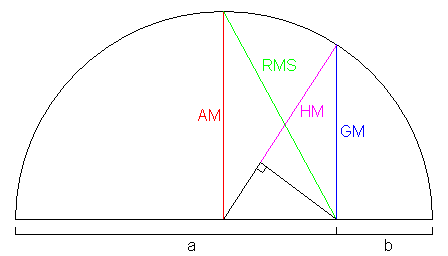Difference between revisions of "Root-Mean Square-Arithmetic Mean-Geometric Mean-Harmonic mean Inequality"
(cleanup) |
|||
| Line 6: | Line 6: | ||
[[Image:RMS-AM-GM-HM.gif|frame|right|The inequality is clearly shown in this diagram for <math>n=2</math>]] | [[Image:RMS-AM-GM-HM.gif|frame|right|The inequality is clearly shown in this diagram for <math>n=2</math>]] | ||
| + | |||
| + | As a consequence we can have the following inequality: | ||
| + | If <math>x_1,x_2,\cdots,x_n</math> are positive reals, then | ||
| + | <math>(x_1+x_2+\cdots+x_n)(\frac{1}{x_1}+\frac{1}{x_2}+\cdots \frac{1}{x_n}) \geq n^2</math> with equality if and only if <math>x_1=x_2=\cdots=x_n</math>; which follows directly by cross multiplication from the AM-HM inequality.This is extremely useful in problem solving. | ||
| + | |||
Revision as of 02:06, 7 January 2009
The Root-Mean Square-Arithmetic Mean-Geometric Mean-Harmonic mean Inequality (RMS-AM-GM-HM), is an inequality of the root-mean square, arithmetic mean, geometric mean, and harmonic mean of a set of positive real numbers ![]() that says:
that says:
![$\sqrt{\frac{x_1^2+\cdots+x_n^2}{n}} \ge\frac{x_1+\cdots+x_n}{n}\ge\sqrt[n]{x_1\cdots x_n}\ge\frac{n}{\frac{1}{x_1}+\cdots+\frac{1}{x_n}}$](http://latex.artofproblemsolving.com/c/e/b/ceb0cbb7b637caa6f14856d9350586808892e419.png)
with equality if and only if ![]() . This inequality can be expanded to the power mean inequality.
. This inequality can be expanded to the power mean inequality.
As a consequence we can have the following inequality:
If ![]() are positive reals, then
are positive reals, then
![]() with equality if and only if
with equality if and only if ![]() ; which follows directly by cross multiplication from the AM-HM inequality.This is extremely useful in problem solving.
; which follows directly by cross multiplication from the AM-HM inequality.This is extremely useful in problem solving.
This article is a stub. Help us out by expanding it.










